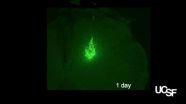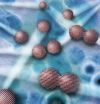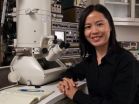(Press-News.org) Chronic pain, by definition, is difficult to manage, but a new study by UCSF scientists shows how a cell therapy might one day be used not only to quell some common types of persistent and difficult-to-treat pain, but also to cure the conditions that give rise to them.
The researchers, working with mice, focused on treating chronic pain that arises from nerve injury -- so-called neuropathic pain.
In their study, published in the March 24, 2012 issue of Neuron, the scientists transplanted immature embryonic nerve cells that arise in the brain during development and used them to make up for a loss of function of specific neurons in the spinal cord that normally dampen pain signals.
A small fraction of the transplanted cells survived and matured into functioning neurons. The cells integrated into the nerve circuitry of the spinal cord, forming synapses and signaling pathways with neighboring neurons.
As a result, pain hypersensitivity associated with nerve injury was almost completely eliminated, the researchers found, without evidence of movement disturbances that are common side effects of the currently favored drug treatment.
"Now we are working toward the possibility of potential treatments that might eliminate the source of neuropathic pain, and that may be much more effective than drugs that aim only to treat symptomatically the pain that results from chronic, painful conditions," said the senior author of the study, Allan Basbaum, PhD, chair of the Department of Anatomy at UCSF.
Although pain and hypersensitivity after injury usually resolve, in some cases they outlast the injury, creating the condition of chronic pain. Many types of chronic pain are induced by stimuli that are essentially harmless — such as light touch — but that are perceived as painful, according to Basbaum.
Chronic pain due to this type of hypersensitivity is often a debilitating medical condition. Many people suffer from chronic neuropathic pain after a bout of shingles, years or decades after the virus that causes chicken pox has been vanquished. Chronic pain is not merely prolonged acute pain, Basbaum said.
Those who suffer from chronic pain often get little relief, even from powerful narcotic painkillers, according to Basbaum. Gabapentin, an anticonvulsant first used to treat epilepsy, now is regarded as the most effective treatment for neuropathic pain. However, it is effective for only roughly 30 percent of patients, and even in those people it only provides about 30 percent relief of the pain, he said.
The explanation for neuropathic pain, research shows, is that following injury neurons may be lost, or central nervous system circuitry may change, in ways that are maladaptive, compromising signals that normally help dampen pain. These changes contribute to a state of hyper-excitability, enhancing the transmission of pain messages to the brain and causing normally innocuous stimuli to become painful.
The inhibitory neurons that are damaged in the spinal cord to cause pain hypersensitivity release a molecule that normally transmits inhibitory signals — the neurotransmitter GABA. A loss of GABA inhibition also is implicated in epilepsy and may play a role in Parkinson's disease. Gabapentin does not mimic GABA, but it helps to compensate for the loss of inhibition that GABA normally would provide.
Basbaum's UCSF colleagues, including study co-authors Arturo Alvarez-Buylla, PhD, and Arnold Kriegstein, MD, PhD, along with Scott Baraban, PhD, had already been experimenting with transplanting immature neurons that make GABA, using the transplanted neurons to bolster inhibitory signals in mouse models to prevent epileptic seizures and to combat a Parkinson's-like disease.
However, in those experiments the cells — which originate in a region of the forebrain known as the medial ganglionic eminence — were transplanted within the brain itself, which is their normal home.
Upon hearing about the research, Basbaum became interested in transplanting the same cells into the spinal cord as a potential treatment for the loss of GABA-driven inhibition in neuropathic pain. Success was by no means assured, as cells normally do not survive outside their natural environments within such a complex organism.
Another co-author of the Neuron study, UCSF researcher John Rubenstein, PhD, has made major progress in identifying molecules that can be manipulated to lead an embryonic stem cell to go through developmental stages that cause it to acquire the properties of GABA neurons that derive from the medial ganglionic eminence.
According to Kriegstein, who directs the Eli and Edythe Broad Center of Regeneration Medicine and Stem Cell Research at UCSF, "This research is at a very early stage, and we're a long way from thinking about it in human trials, but we do have a method of making cells that are like these inhibitory neurons, starting with human embryonic stem cells."
As a step toward eventual therapies, the UCSF team plans to graft fetal human cells from the medial ganglionic eminence, or cells derived from human embryonic stem cells, into a rodent model of neuropathic pain, to see if the human cells also will alleviate neuropathic chronic pain.
"Unlike drugs, the transplanted cells can have very focused effects, depending on where they are transplanted," Kriegstein said.
According to Alvarez-Buylla, a leading scientist among those working to define the potentialities of various cells in the developing brain at different stages, "One of the amazing properties of these cells from the medial ganglionic eminence is their unprecedented migratory capacity, which enables them to navigate through multiple terrains within the central nervous system, and to then become functionally integrated with other cells. Those properties have proved useful in other places where we have transplanted them, and now in the spinal cord."
INFORMATION:
Joao Braz, PhD, an assistant research scientist, and Reza Sharif-Naieni, PhD, a postdoctoral fellow, both working in the Basbaum laboratory, carried out the bulk of the experiments published in Neuron. The authors have a patent pending on the treatment outlined in the study.
The study was funded by the National Institutes of Health, the Association for the Study of Pain and the Canadian Institutes of Health Research.
UCSF is a leading university dedicated to promoting health worldwide through advanced biomedical research, graduate-level education in the life sciences and health professions, and excellence in patient care.
RELATED LINKS:
Pain Control is Focus of Allan Basbaum's Research Career
May 2, 2012
http://www.ucsf.edu/news/2012/05/11969/pain-control-focus-allan-basbaums-research-career
UCSF Stem-Cell Based Neurological, Liver Therapy Strategies Advanced
October 22, 2010
http://www.ucsf.edu/news/2010/10/5783/ucsf-stem-cell-based-neurological-liver-therapy-strategies-advanced
Novel Parkinson's Treatment Strategy Involves Cell Transplantation
March 25, 2010
http://www.ucsf.edu/news/2010/03/4384/novel-parkinsons-treatment-strategy-involves-cell-transplantation
New Period of Brain "Plasticity" Created With Transplanted Embryonic Cells
March 25, 2010
http://www.ucsf.edu/news/2010/03/4383/new-period-brain-plasticity-created-transplanted-embryonic-cells
Chronic pain is relieved by cell transplantation in lab study
UCSF scientists aim to use embryonic stem cells for treatment
2012-05-28
ELSE PRESS RELEASES FROM THIS DATE:
Gourmet butterflies speed north
2012-05-28
A new study led by scientists in the Department of Biology at the University of York has shown how a butterfly has changed its diet, and consequently has sped northwards in response to climate change.
Their study is published in the latest issue of Science.
The researchers found that warmer summers have allowed the Brown Argus butterfly to complete its life cycle by eating wild Geranium plants. Because the Geraniums are widespread in the British countryside, this change in diet has allowed the butterfly to expand its range in Britain at a surprisingly rapid rate. Over ...
The cells' petrol pump is finally identified
2012-05-28
Our cells breathe and digest, as does the organism as a whole. They indeed use oxygen to draw the energy contained in the nutrients they ingest, before discarding the waste, as carbon dioxide and water. Glucose is a preferred nutrient for the cells. Its digestion occurs in the cytoplasm, in the absence of oxygen, and leads to the formation of pyruvate and a small amount of energy. Pyruvate is then carried into mitochondria, the cell's power plants, for a complete burning, thus providing a maximal energetic yield.
A mediocre energetic yield in tumor cells
'As opposed ...
CWRU class earns Science magazine prize for innovation
2012-05-28
Science magazine has awarded a prize for Inquiry-Based Instruction to a Case Western Reserve University class that melds biology, computer modeling, mathematical analysis and writing.
"Dynamics of Biological Systems," taught by Biology Professor Hillel Chiel and three graduate assistants, abandons traditional lectures altogether in favor of learning by doing. The teachers call the class an example of the use of the continual improvement model in education.
In it, Chiel pairs biology majors with engineering, physics or math majors, and has them concentrate on building ...
First direct observation of oriented attachment in nanocrystal growth
2012-05-28
Through biomineralization, nature is able to produce such engineering marvels as mother of pearl, or nacre, the inner lining of abalone shells renowned for both its iridescent beauty and amazing toughness. Key to biomineralization is the phenomenon known as "oriented attachment," whereby adjacent nanoparticles connect with one another in a common crystallographic orientation. While the importance of oriented attachment to biomineral properties long has been recognized, the mechanism by which it occurs has remained a mystery. With a better understanding of oriented attachment ...
Nanoparticles seen as artificial atoms
2012-05-28
VIDEO:
Berkeley Lab researchers at the National Center for Electron Microscopy recorded real-time observations of nanocrystal growth that support the theory of nanoparticles acting like artificial atoms. This electron microscopy movie...
Click here for more information.
In the growth of crystals, do nanoparticles act as "artificial atoms" forming molecular-type building blocks that can assemble into complex structures? This is the contention of a major but controversial ...
Knowing genetic makeup may not significantly improve disease risk prediction
2012-05-28
Boston, MA —Harvard School of Public Health (HSPH) researchers have found that detailed knowledge about your genetic makeup—the interplay between genetic variants and other genetic variants, or between genetic variants and environmental risk factors—may only change your estimated disease prediction risk for three common diseases by a few percentage points, which is typically not enough to make a difference in prevention or treatment plans. It is the first study to revisit claims in previous research that including such information in risk models would eventually help doctors ...
Pivotal role for proteins -- from helping turn carbs into energy to causing devastating disease
2012-05-28
(SALT LAKE CITY)—Research into how carbohydrates are converted into energy has led to a surprising discovery with implications for the treatment of a perplexing and potentially fatal neuromuscular disorder and possibly even cancer and heart disease.
Until this study, the cause of this neuromuscular disorder was unknown. But after obtaining DNA from three families with members who have the disorder, a team led by University of Utah scientists Jared Rutter, Ph.D., associate professor of biochemistry and Carl Thummel, Ph.D., professor of human genetics, sequenced two genes ...
Discarded data may hold the key to a sharper view of molecules
2012-05-28
CORVALLIS, Ore. — There's nothing like a new pair of eyeglasses to bring fine details into sharp relief. For scientists who study the large molecules of life from proteins to DNA, the equivalent of new lenses have come in the form of an advanced method for analyzing data from X-ray crystallography experiments.
The findings, just published in the journal Science, could lead to new understanding of the molecules that drive processes in biology, medical diagnostics, nanotechnology and other fields.
Like dentists who use X-rays to find tooth decay, scientists use X-rays ...
No new neurons in the human olfactory bulb
2012-05-28
Research from Karolinska Institutet in Sweden shows that the human olfactory bulb – a structure in the brain that processes sensory input from the nose – differs from that of other mammals in that no new neurons are formed in this area after birth. The discovery, which is published in the scientific journal Neuron, is based on the age-determination of the cells using the carbon-14 method, and might explain why the human sense of smell is normally much worse than that of other animals.
"I've never been so astonished by a scientific discovery," says lead investigator Jonas ...
Gene discovery points towards new type of male contraceptive
2012-05-28
A new type of male contraceptive could be created thanks to the discovery of a key gene essential for sperm development.
The finding could lead to alternatives to conventional male contraceptives that rely on disrupting the production of hormones, such as testosterone and can cause side-effects such as irritability, mood swings and acne.
Research, led by the University of Edinburgh, has shown how a gene – Katnal1 – is critical to enable sperm to mature in the testes.
If scientists can regulate the Katnal1 gene in the testes, they could prevent sperm from maturing ...
LAST 30 PRESS RELEASES:
Making lighter work of calculating fluid and heat flow
Normalizing blood sugar can halve heart attack risk
Lowering blood sugar cuts heart attack risk in people with prediabetes
Study links genetic variants to risk of blinding eye disease in premature infants
Non-opioid ‘pain sponge’ therapy halts cartilage degeneration and relieves chronic pain
AI can pick up cultural values by mimicking how kids learn
China’s ecological redlines offer fast track to 30 x 30 global conservation goal
Invisible indoor threats: emerging household contaminants and their growing risks to human health
Adding antibody treatment to chemo boosts outcomes for children with rare cancer
Germline pathogenic variants among women without a history of breast cancer
Tanning beds triple melanoma risk, potentially causing broad DNA damage
Unique bond identified as key to viral infection speed
Indoor tanning makes youthful skin much older on a genetic level
Mouse model sheds new light on the causes and potential solutions to human GI problems linked to muscular dystrophy
The Journal of Nuclear Medicine ahead-of-print tip sheet: December 12, 2025
Smarter tools for peering into the microscopic world
Applications open for funding to conduct research in the Kinsey Institute archives
Global measure underestimates the severity of food insecurity
Child survivors of critical illness are missing out on timely follow up care
Risk-based vs annual breast cancer screening / the WISDOM randomized clinical trial
University of Toronto launches Electric Vehicle Innovation Ontario to accelerate advanced EV technologies and build Canada’s innovation advantage
Early relapse predicts poor outcomes in aggressive blood cancer
American College of Lifestyle Medicine applauds two CMS models aligned with lifestyle medicine practice and reimbursement
Clinical trial finds cannabis use not a barrier to quitting nicotine vaping
Supplemental nutrition assistance program policies and food insecurity
Switching immune cells to “night mode” could limit damage after a heart attack, study suggests
URI-based Global RIghts Project report spotlights continued troubling trends in worldwide inhumane treatment
Neutrophils are less aggressive at night, explaining why nighttime heart attacks cause less damage than daytime events
Menopausal hormone therapy may not pose breast cancer risk for women with BRCA mutations
Mobile health tool may improve quality of life for adolescent and young adult breast cancer survivors
[Press-News.org] Chronic pain is relieved by cell transplantation in lab studyUCSF scientists aim to use embryonic stem cells for treatment


